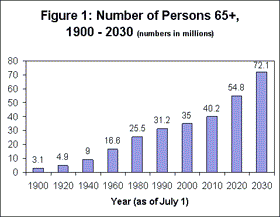Posts tagged ‘Demographics’
Boom Towns
Worldchanging’s article on Boom Towns has me thinking about the effects of an aging population on the SF Bay Area.
In 2011, the first Boomer will turn 65, an occasion that will herald an epochal demographic shift. Just as babies boomed in the 1940s through 1960s, older adults will become North America’s – and much of the rest of the world’s – fastest-growing demographic. This imminent population shift is beginning to force a long-overdue conversation about the unique housing, environmental, and health care needs of an aging population.
Unfortunately, it’s a conversation that many of us are ill-prepared to undertake. A recent AARP study, for example, found a massive disconnect between perceptions of aging and its reality.
…These issues came to life for me several years ago, when my father, a California school teacher, started looking for his future retirement home in Oregon’s Willamette Valley. His criteria for the move, “I want to get away from the crowded [city] and find a place that is less hectic…somewhere I can grow things.”
…My father simply couldn’t fathom the changes that age would bring to his abilities or his faculties. Even though he has never wanted to burden anyone, it was tough for him to envision the kind of decline that would lead to needing help with driving, shopping—or growing things.
…Eventually we found a house across the street from a hospital, a half mile from a future light rail stop, with a ramp over the three stairs leading to the front door, and with plenty of room on the property to add additional square footage or an accessory dwelling unit if my sister, our family, or his friends wanted to join him in Portland.
California is a comparatively “young” state with a high birth rate, but it is not immune to the aging boom. The proportion of residents 60+ years of age is expected to increase by 59 percent between 2005 and 2020. By then, one in five Californians will be over 60.
And then there’s population growth and the sheer number of older people, continuing to grow sharply through 2030 at least.

The state’s report “Aging California” (pdf) notes that this growth will be unevenly distributed. Rural counties currently have lower populations, but a greater percentage of seniors. This is due to the flight of younger residents to urban areas to find work, plus the influx of retirees seeking new homes away from large cities.
Looking at local projections for the future, it’s harder to see a trend. For example, the Lassen-Shasta-Trinity area is expected to age slightly less than San Francisco (39% increase vs. 43%, if that’s significant). These are in turn surpassed by Riverside and San Diego (each near the average of 59%), Contra Costa (66%), and Sonoma (86%). It’s a complex mix of birth rates, employment patterns, migration, affordability, and retirement—and I’m sure none of these numbers reflect the recent financial meltdown.
Personally, I’m becoming increasingly mindful of transit patterns in my daily life. That last bus link from home to BART is weak—nonexistent at night—which means driving to the train station. Nor does the design of my home fit the Portland scenario above. More to think about. I’m determined to do better in my next move. And I won’t be tempted by anything like my in-laws’ Prescott Valley exurban retirement, no matter how inexpensive the real estate.
